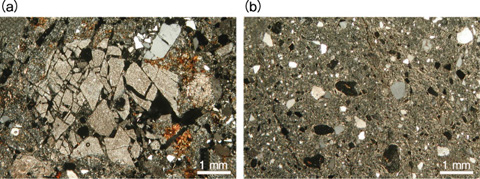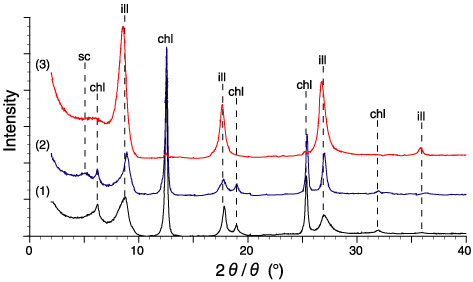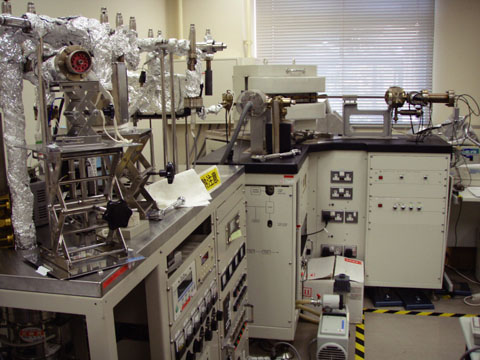
Fig.2-11 Photomicrographs of fractured rocks in a fault zone

Fig.2-12 X-ray diffraction (XRD) pattern for fault gouge

Fig.2-13 Noble-gas mass spectrometer for K-Ar dating
Rock fracturing, which is caused by fault displacement, leads to the formation of “fault zones” characterized by the aggregations of rock fragments and development of numerous cracks. The depth of the fault zone formation and the direction of fault displacement can be reconstructed on the basis of the deformation features of the rocks and minerals in a fault zone.
There are many faults in the Japanese Islands located on the boundary of the continental and oceanic plates. Prediction of future fault activities is significant for not only earthquake disaster prevention but also safety management of the geological disposal of high-level radioactive waste.
We have reconstructed the history of fault development on the basis of the spatial distribution and characteristics of the fault zones. In our study, we have revealed the spatial distribution of the fault zones through detailed field mapping and described the characteristics of fault zones through field sketches of fault outcrops and observations of fractured rocks and minerals by optical and electronic microscopes (Fig.2-11). Such a reconstructed history can be an important rationale for predicting future fault activities.
Water-rock interaction and subsequent formation of alteration minerals are observed in fault zones because the cracks in fractured rocks often become dominant groundwater paths. The type and distribution of the alteration minerals reflect the underground environment (water quality, temperature, etc.) where fault zones are situated when the water-rock interaction occurs. Thus, the study of alteration minerals is important for understanding the change in the underground environment, which is associated with fault zone development.
Clay minerals are typical alteration minerals formed in a fault zone. Fault gouge, which is an unconsolidated thin layer in a fault zone and composed of very fine minerals and rock fragments, is formed by intense, repetitive fault activities associated with rock fragmentation and water-rock interaction. Clay minerals such as illite, smectite, chlorite, and kaolinite are often present in a fault gouge (Fig.2-12). Illite is used in radiometric dating based on the measurement of the product of the radioactive decay of an isotope of potassium into argon (K-Ar dating; Fig.2-13). Thus, K-Ar dating of illite can be useful for determining the absolute age of fault development from the reconstructed history. However, it is technically difficult to distinguish authigenic, very fine illite, in a fault gouge, from other potassium-bearing minerals in and around a fault zone. We have also challenged the development of such a difficult radiometric age dating method.